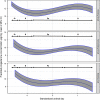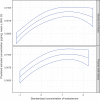The quantification of reproductive hormones in the hair of captive adult brown bears and their application as indicators of sex and reproductive state
- PMID: 28580147
- PMCID: PMC5452076
- DOI: 10.1093/conphys/cox032
The quantification of reproductive hormones in the hair of captive adult brown bears and their application as indicators of sex and reproductive state
Abstract
Recognizing the potential value of steroid hormone measurements to augment non-invasive genetic sampling, we developed procedures based on enzyme-linked immunoassays to quantify reproductive steroid hormone concentrations in brown bear (Ursus arctos) hair. Then, using 94 hair samples collected from eight captive adult bears over a 2-year period, we evaluated (i) associations between hair concentrations of testosterone, progesterone, estradiol and cortisol; (ii) the effect of collecting by shaving vs. plucking; and (iii) the utility of reproductive hormone profiles to differentiate sex and reproductive state. Sample requirements (125 mg of guard hair) to assay all hormones exceeded amounts typically obtained by non-invasive sampling. Thus, broad application of this approach will require modification of non-invasive techniques to collect larger samples, use of mixed (guard and undercoat) hair samples and/or application of more sensitive laboratory procedures. Concentrations of hormones were highly correlated suggesting their sequestration in hair reflects underlying physiological processes. Marked changes in hair hormone levels during the quiescent phase of the hair cycle, coupled with the finding that progesterone concentrations, and their association with testosterone levels, differed markedly between plucked and shaved hair samples, suggests steroids sequestered in hair were likely derived from various sources, including skin. Changes in hair hormone concentrations over time, and in conjunction with key reproductive events, were similar to what has been reported concerning hormonal changes in the blood serum of brown bears. Thus, potential for the measurement of hair reproductive hormone levels to augment non-invasive genetic sampling appears compelling. Nonetheless, we are conducting additional validation studies on hair collected from free-ranging bears, representative of all sex, age and reproductive classes, to fully evaluate the utility of this approach for brown bear conservation and research.
Keywords: Brown bear; Ursus arctos; enzyme-linked immunoassay; hair cortisol; hair reproductive hormone profile; non-invasive genetic sampling.
Figures












Similar articles
-
Can concentrations of steroid hormones in brown bear hair reveal age class?Conserv Physiol. 2018 Jan 29;6(1):coy001. doi: 10.1093/conphys/coy001. eCollection 2018. Conserv Physiol. 2018. PMID: 29399362 Free PMC article.
-
Analysis of hair steroid hormones in polar bears (Ursus maritimus) via liquid chromatography-tandem mass spectrometry: comparison with two immunoassays and application for longitudinal monitoring in zoos.Gen Comp Endocrinol. 2021 Sep 1;310:113837. doi: 10.1016/j.ygcen.2021.113837. Epub 2021 Jun 26. Gen Comp Endocrinol. 2021. PMID: 34181933
-
Stress and reproductive hormones in hair associated with contaminant metal(loid)s of European brown bear (Ursus arctos).Chemosphere. 2023 Jun;325:138354. doi: 10.1016/j.chemosphere.2023.138354. Epub 2023 Mar 10. Chemosphere. 2023. PMID: 36907481
-
Measuring adrenal and reproductive hormones in hair from Southern Beaufort Sea polar bears (Ursus maritimus).Gen Comp Endocrinol. 2021 Sep 1;310:113807. doi: 10.1016/j.ygcen.2021.113807. Epub 2021 May 6. Gen Comp Endocrinol. 2021. PMID: 33964286
-
Reproductive hormone measurement from minimally invasive sample types: Methodological considerations and anthropological importance.Am J Hum Biol. 2021 Jan;33(1):e23535. doi: 10.1002/ajhb.23535. Epub 2020 Nov 10. Am J Hum Biol. 2021. PMID: 33174269 Review.
Cited by
-
Development and validation of protein biomarkers of health in grizzly bears.Conserv Physiol. 2020 Jun 24;8(1):coaa056. doi: 10.1093/conphys/coaa056. eCollection 2020. Conserv Physiol. 2020. PMID: 32607241 Free PMC article.
-
Assessment of stress levels and reproductive condition in giant pandas: insights from hair, faecal and saliva samples.Conserv Physiol. 2024 Jul 3;12(1):coae044. doi: 10.1093/conphys/coae044. eCollection 2024. Conserv Physiol. 2024. PMID: 38962510 Free PMC article.
-
Correcting for enzyme immunoassay changes in long term monitoring studies.MethodsX. 2021 Jan 6;8:101212. doi: 10.1016/j.mex.2021.101212. eCollection 2021. MethodsX. 2021. PMID: 34434735 Free PMC article.
-
Testosterone levels in hair of free-ranging male northern fur seals (Callorhinus ursinus) in relation to sampling month, age class and spermatogenesis.Conserv Physiol. 2021 May 17;9(1):coab031. doi: 10.1093/conphys/coab031. eCollection 2021. Conserv Physiol. 2021. PMID: 34026214 Free PMC article.
-
Multi-year patterns in testosterone, cortisol and corticosterone in baleen from adult males of three whale species.Conserv Physiol. 2018 Sep 21;6(1):coy049. doi: 10.1093/conphys/coy049. eCollection 2018. Conserv Physiol. 2018. PMID: 30254748 Free PMC article.
References
-
- Agnew RCN, Smith VJ, Fowkes RC (2016) Wind turbines cause chronic stress in badgers (Meles meles) in Great Britain. J Wildl Dis 52: 459–467. - PubMed
-
- Amoh Y, Li L, Yang M, Jiang P, Moosa AR, Katsuoka K, Hoffman RM (2005) Hair follicle-derived blood vessels vascularize tumors in skin and are inhibited by doxorubicin. Cancer Res 65: 2337–2343. - PubMed
-
- Arnon L, Hazut N, Tabachnik T, Weller A, Koren L (2016) Maternal testosterone and reproductive outcome in a rat model of obesity. Theriogenology 86: 1042–1047. - PubMed
-
- Bartoń K. (2016) Multi-model inference CRAN Version 1.15.6, pp 1–63.
LinkOut - more resources
Full Text Sources
Other Literature Sources

